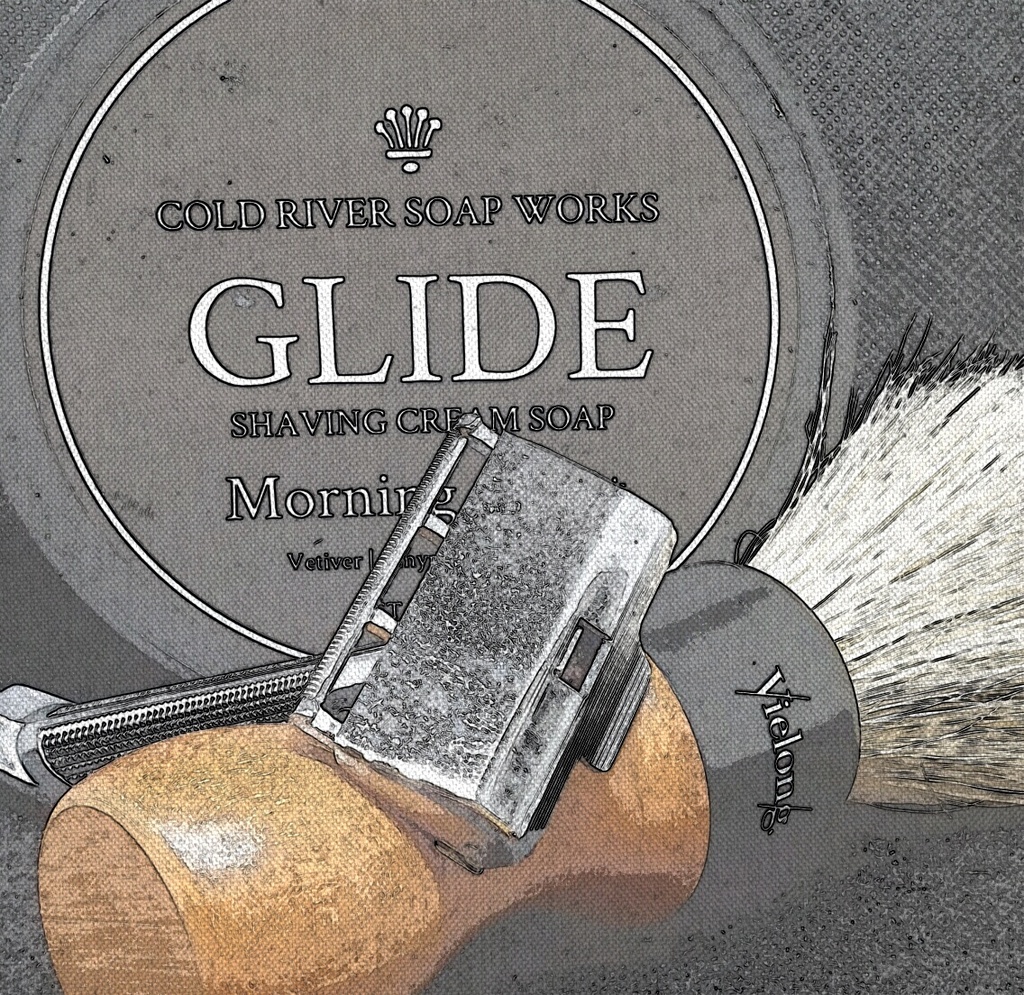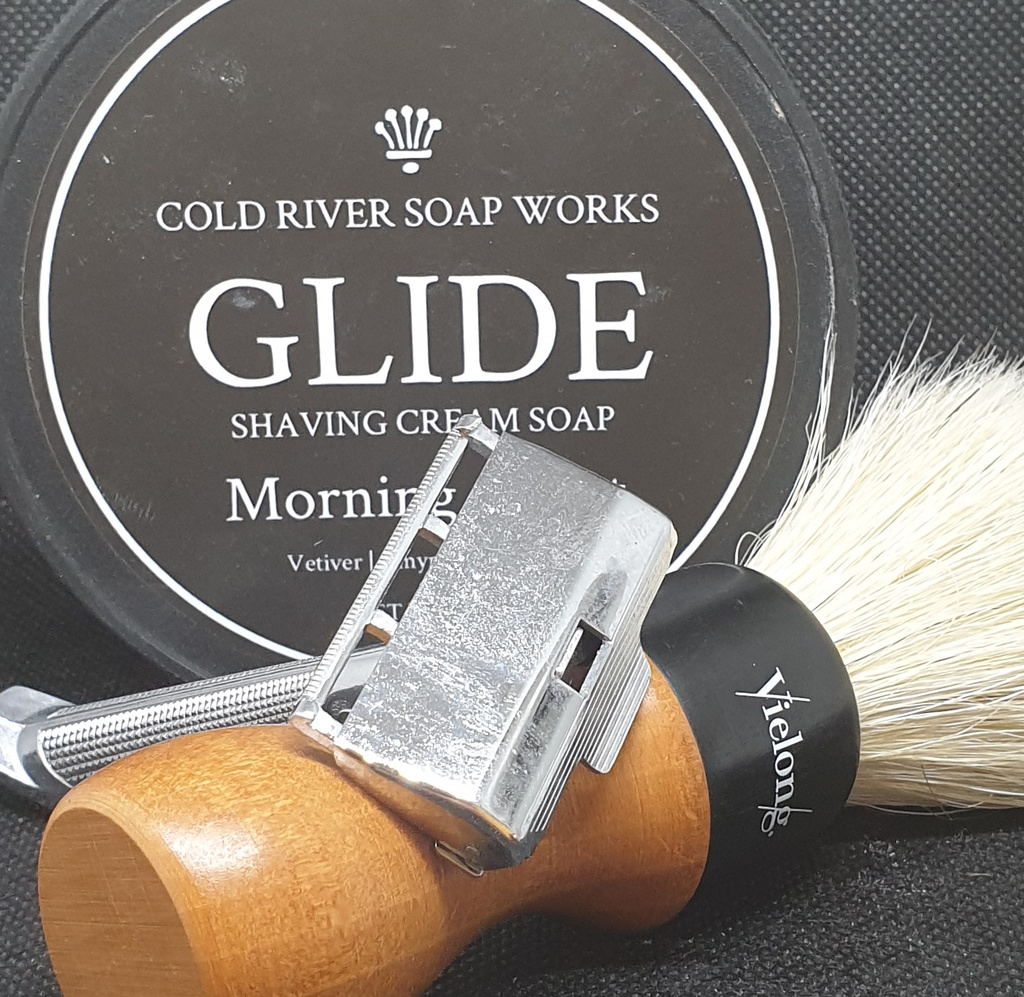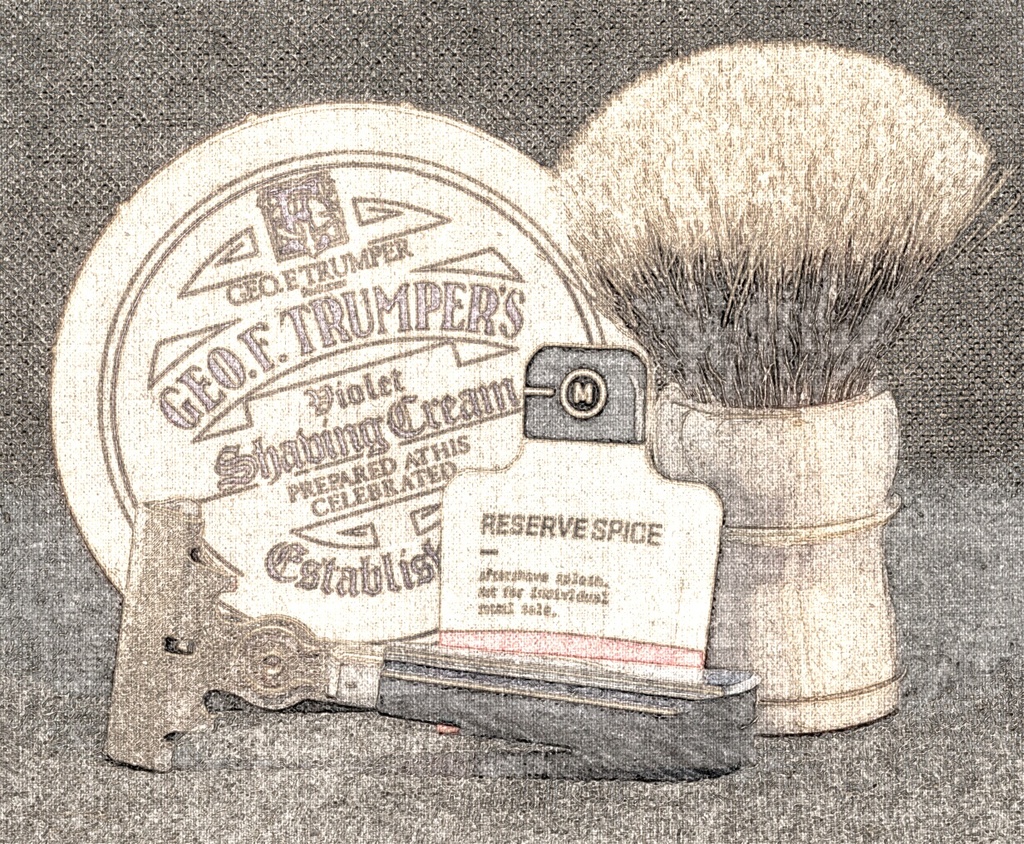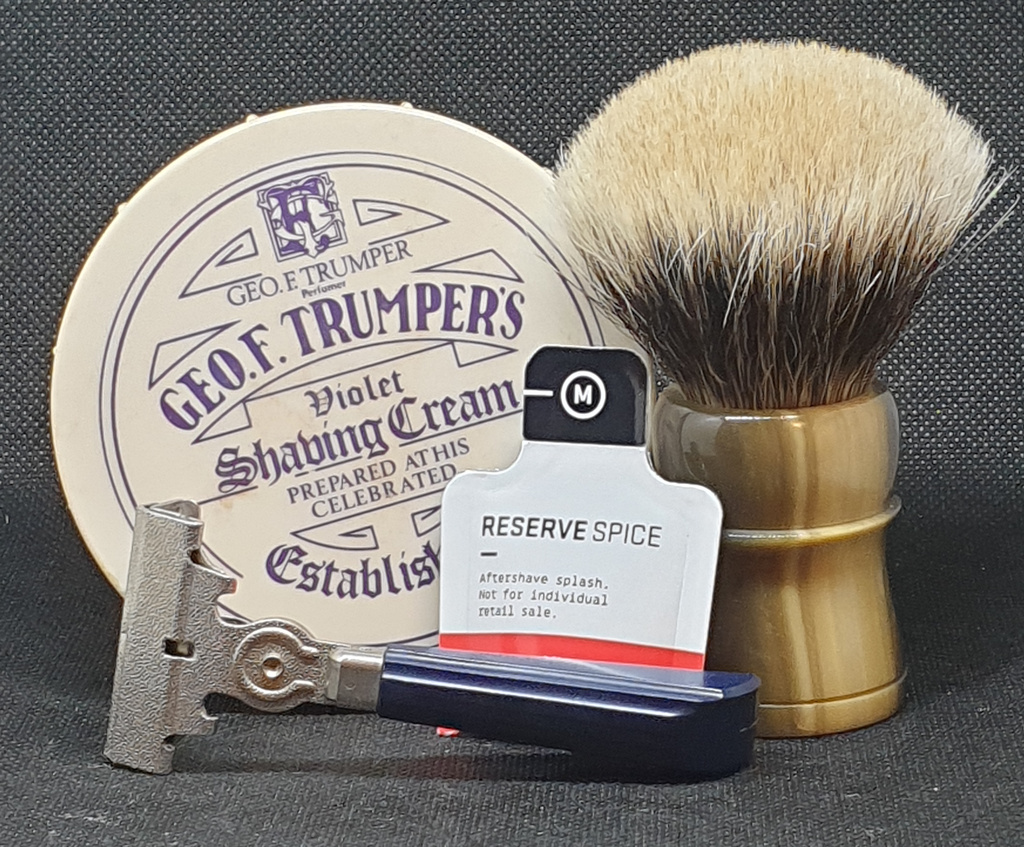Razor: GEM Heavy Flat Top
Blade: GEM Single Edge Stainless
Brush: Wilkinson Sword Badger
Lather: Arko Shavestick
Aftershave: BullDog Original Aftershave Balm
Additional Care: Alum Block
Monthly Archives: July 2020
Otto Spahr’s sort-of-slant razor
In the commonly used type of safety razor, the axis of the handle extends at right angle to the longitudinal direction of extension of the blade. The natural and most convenient mode of operating such a razor is to pull it across the surface of the face in a user experiences more or less discomfort.
Otto Spahr in US patent 1,639,441
Reading the introductory paragraph of Otto Spahr’s patent, I get the feeling he could be a bit snarky at times. But he has a point – the common safety razor isn’t the most ergonomic design. And if you’re using the “Gillette Slide” – which some sources indicate was a common technique – it was even less good. Possible solutions includes the slant, an offset handle, or having the head at an angle to the handle.
Mr Spahr picked the later approach, and seems to have gotten the idea that no set angle suits everyone. So he came up with a design that allowed for near infinite adjustment of the handle. In the words of the inventor:
Another object of the invention is to so hinge the razor-carrying frame to the handle that the handle may be adjusted to any desired angle to the blade, so that the axis of the handle will not only extend at an oblique angle to the longitudinal direction of extension of the bla e, but maybe within the plane of the longitudinal centerline .of the blade or at an angle to such plane, as the user may prefer.
Otto Spahr in US patent 1,639,441
A spring loaded ball joint meant that there were no screw threads that can seize up. The spring pressure must be calibrated, to stop the handle from either being beeing too stiff or too loose.
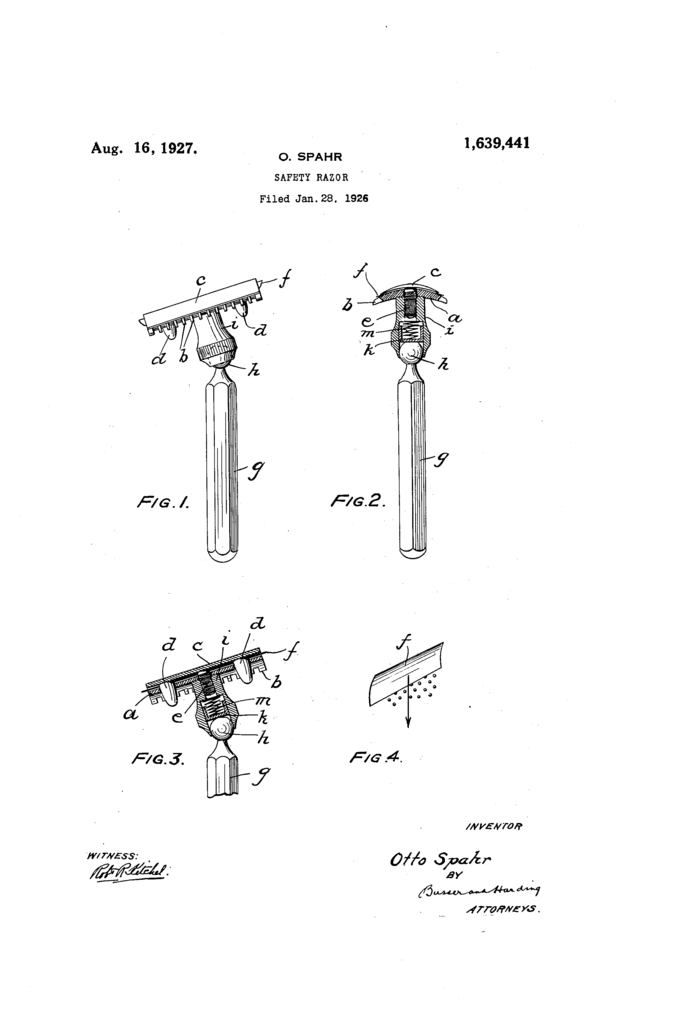
While not an adjustable razor per see, Spahr’s razor offers opportunity for a lot of adjustment. I can certainly see it being of interest for people with less than full use of their hands, for one reason or other.
Shave of the day 29th July
Razor: GEM Heavy Flat Top
Blade: GEM Single Edge Stainless
Brush: Vie-Long #13051M
Lather: GzD Shavestick (mushed into a tub)
Aftershave: Sample
Additional Care: Alum Block
…a plurality of very flat brush elements…
As most traditional wetshavers knows, a shaving brush works best if it’s not too small. This can have some drawbacks, especially if you’re travelling. To quote the inventor Michel Charles Blondin;
Shaving brushes used for putting soap on the skin before shaving should be preferably somewhat large. Consequently they take a long time drying and are difficult to clean; moreover they are comparatively cumbersome and cannot be put away in a small or flat dressing-case for transportation.
Michel Charles Blondin in US patent 1,786,224
The most modern solution seems to be having your travel brush made out of synthetic fibers, or being able to be retracted into a container. My own travel brush, for example, is an Omega 50014 – which neatly fits in it’s own handle. Mr Blondin’s solution was slightly more complex and actually rather interesting. In his own words again:
My improved shaving brush comprises a plurality of very flat brush elements adapted to be assembled to form the brush ready for use.
Michel Charles Blondin in US patent 1,786,224
As the patent drawing hopefully makes clear, the plurality of brush elements pivoted together could either be folded up as a cube-shaped handle with a squarish brush – or it could be flattened out to a long and flat brush that would dry quickly. Other forms the brush could take would be – according to the patent description – a flat elastic strip that could be rolled up, or small flat segments can can be stacked inside a holder. A holder could also optionally be used for the rolled up elastic strip and the hinged variations of the brush.
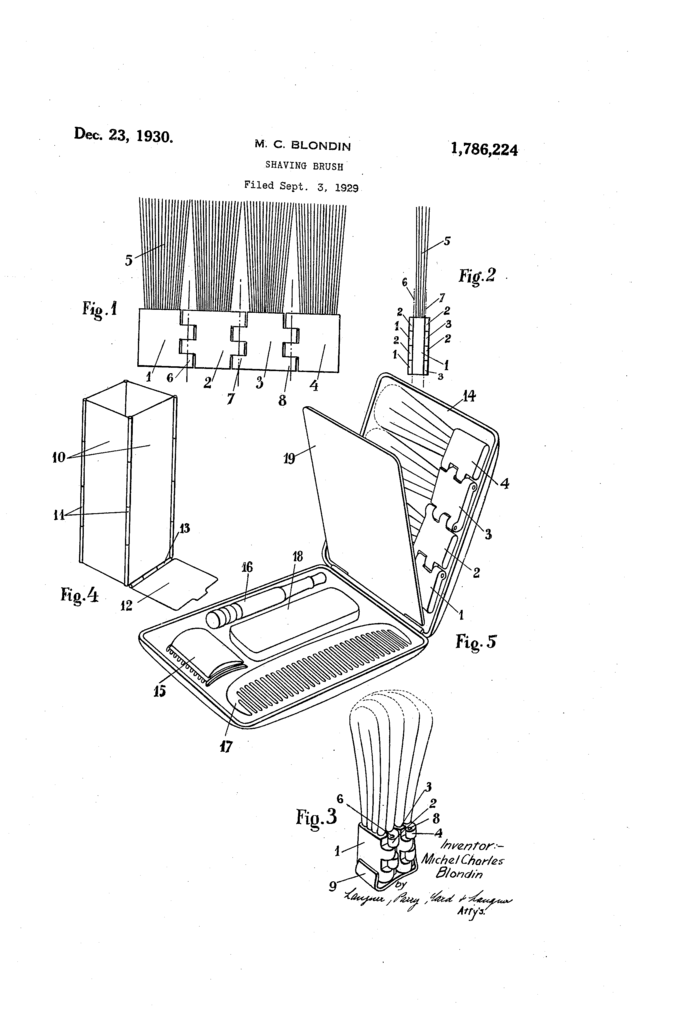
The patent drawing shows his new and improved brush in a hinged box with a full set of shaving gear, including soap (item 18 on the drawing). The whole shaving gear would be – he claims – flat enough to be carried in a pocket.
I can actually see the use of a brush like this today as well; it’s a niche market, but it would suit those of us who both like to have a proper shave on the go, and have to deal with living out of a small GoBag for a few days at a time. The only real question is if that niche in the market is large enough for a modern manufacturer of shaving brushes to invest the time, effort, and resources to produce it.
The original patent description and text can be found both at Google Patents and at Razors.click.
Shave of the day 27th July
Shave of the day 24th July
Razor: Shick G4
Blade: Schick Injector
Brush: Omega #10048
Lather: Palmolive Sensitive w/ aloe vera
Aftershave: Sample
Additional Care: Alum Block
Razors.click – a website and a resource
As some of you might have noticed, I like patents for old razors and related accoutrements. Like enough to have many, many posts about them. Enough to self publish a book about them. And more than enough to appreciate the work behind a site like razors.click.
Razors.click is a site mostly about razor patents. It have some added bonuses like a handful of inventor biographies, a few articles on razor related subjects, and short how-to’s on how to make your own wedge blade and taking 360° images. The main focus is on patents though, and where I will show of a patent and either snark on some of the odd details or ramble about the things I like, razors.click lays out the patent in a clear, readable format with interactive drawings.
Razors.click is a good resource for anyone who likes old razors and engineering. Personally I would enjoy seeing more shaving related accoutrements – brushes and bowls – but it is a great resource both for research and relaxation. Go check it out.
Shave of the day 22nd July
Razor: Shick G4
Blade: Schick Injector
Brush: Semogue TSN 2012 LE
Lather: Asylum Shave Work’s Frankincense & Myrrh
Aftershave: Sample
Additional Care: Alum Block
The Man With the Hoe – Shaving
As I’ve mentioned before Gillette wasn’t the only one trying to invent and patent a perfected safety razor around the turn of the last century. One of the main competitors was Russ Jackson Christy and his family of Christy Hoe Razors.
I’ve mentioned Christy’s razors in passing before, but here we have the real deal. Not a razor using a Christy blade, not a razor similar to a Christy Hoe, but an early advertisement for a proper Christy Hoe. And while this ad reads rather different than the one we looked at last week – due to being aimed at a different class of audience perhaps – it still have a lot of words and is rather information dense compared to advertisements of today.
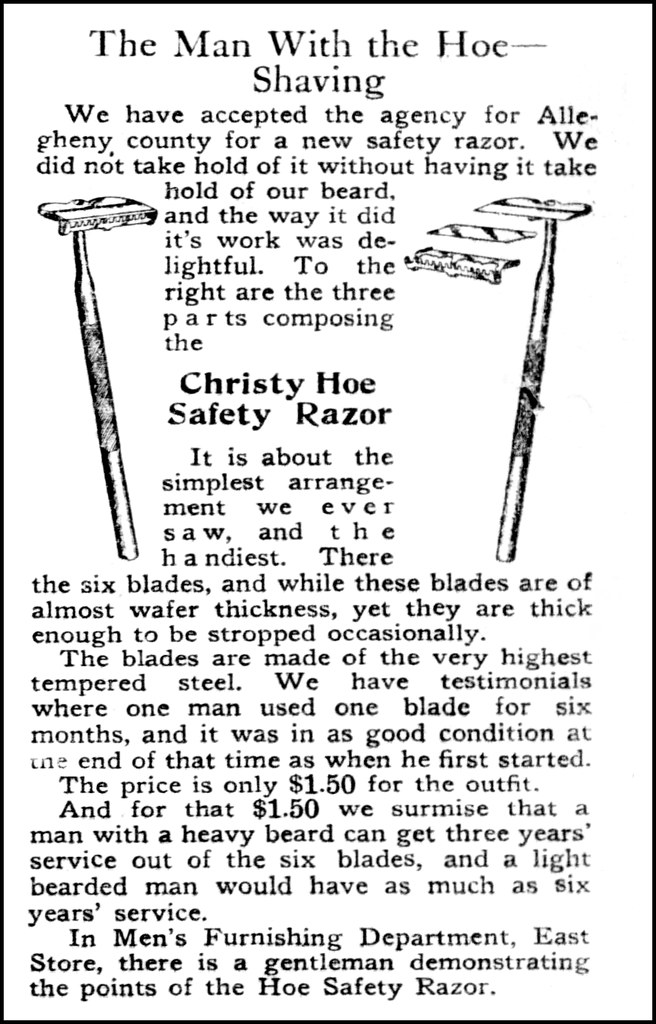
I like his this ad reads much like I expect a gentleman of the era to talk. It comes across as informal, is information dense, yet don’t move into information overload.
Allegedly a delightful razor to use, the also highlights the razor’s simplicity. And with just three pieces – handle, blade, and guard – it’s hard to imagine something simpler. And while Gillette advertised a year or so later than blades were inexpensive enough to be thrown away like an old pen nib, one of Christy’s selling points were that the blades were thick enough to strop and would last for months. This alone suggest that the marked for Christy wasn’t the rich, but the frugal.
For as little as 1.50$ – or about 44 US dollars today – you not only got the razor, but also half a dozen blades. Not bad for a frugal man, since that could potentially translate into three years of shaves at a mere fifty cents a year.
If I’m to judge by the drawing and the date, my guess is that the razor being demonstrated in the Men’s Furnishing Department was based of Russ Jackson Christy’s patent US 788,820. For those that are curious, the patent can be viewed either at Google Patent Search or over at razors.click (easier to read, and interactive).

